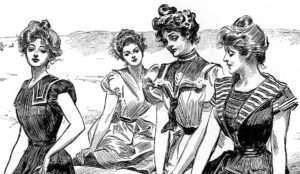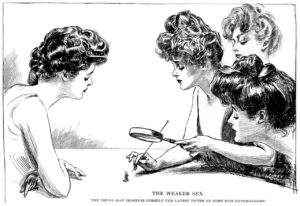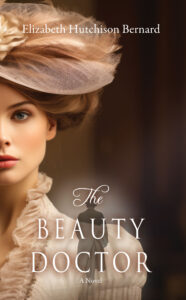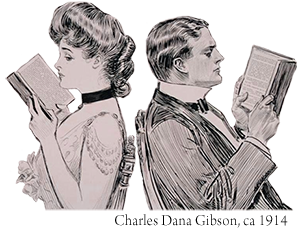The Allure of the “Gibson Girl”
Who was the iconic Gibson Girl, making her debut at the turn of the nineteenth century, and what was her significance to Edwardian times? According to her creator, artist Charles Dana Gibson (1867-1944), the Gibson Girl was not any one individual but, rather, a composite of the all-American girl/woman. Undeniably, her impact on society in the early 1900s was significant. 
The Gibson Girl began as a pen and ink drawing composed in the 1890s, and she ultimately became a ubiquitous presence, widely accepted around the world as symbolic of the new American woman. She was, of course, always beautiful and chic—no matter what she was doing or with whom she was doing it. But that was the point. The Gibson Girl could be tall, strong, sporty, spirited, and independent without losing one ounce of her feminine allure. Her hourglass figure, her perfect chignon of upswept curls, her fashionable attire, her self-confident and slightly mysterious smile—all of this served to make her the symbol of women’s new freedom and their potential power in society. The mild arrogance of the Gibson Girl even made it possible to imagine a world in which men were at a woman’s beck and call—to be controlled, not obeyed! But because the Gibson Girl was, above all else, well-bred—though perhaps not in the traditional sense of the word—she could be presumed to know what limits to exert on her own power.
In my historical suspense-thriller, The Beauty Doctor, two of the characters make reference to the Gibson Girl: 1) The eccentric inventor, Joe Radcliff, compares Abigail Platford, a young woman with aspirations to become a doctor, to the magazine image of a Gibson Girl. His intent, rather than complimentary, is to demonstrate that he doesn’t take her ambitions seriously. 2) Beauty doctor Franklin Rome is a self-proclaimed pioneer in the shocking new surgery that sculpts noses, trims drooping eyelids, lifts jowls, and smooths wrinkles with injections of paraffin wax. He speaks of the Gibson Girl while explaining to Abigail his concept of beauty:
“I’ve made a great study of it, as you know, and I can tell you without a doubt that it is the mixture of different types that creates the most compelling beauty in a woman. That’s why the Gibson Girl is so admired. She’s a composite. The artist himself said she’s the product of America’s melting pot. She’s unique.”
It is true that Charles Gibson said about his Gibson Girl creations: “They are beyond question the loveliest of all their sex . . . The eventual American woman will be even more beautiful than the woman of today. Her claims to that distinction will result from a fine combination of the best points of all those many races which have helped to make our population.” But lest you imagine that the Edwardian era was an “enlightened” age, consider the rise of the eugenics movement which sought to create a “super race” through authoritarian control of human reproduction. During the early twentieth century, eugenics was widely embraced by academic institutions and governments throughout the world. Many wealthy individuals like Carnegie and Rockefeller contributed sizeable sums of money for eugenics research. It was not until the 1930s that enthusiasm for the doctrine began its decline. By the end of World War II, eugenics was widely discredited. However, practices of forced limits on reproduction, as well as involuntary sterilizations and hysterectomies, continue in some countries to the present day. In The Beauty Doctor, the aspiring doctor Abigail Platford must battle a corrupt establishment that will go to any lengths in pursuit of its twisted ideology.
But back to the Gibson Girl: Whatever one’s opinion of her—on the one hand, she was idolized, on the other many of her era criticized her for perpetuating an unrealistic image of womanhood—she made Charles Dana Gibson a household name and strongly influenced an entire generation of women.
 The artist, by the way, also created the Gibson Man, but the popularity of the male version never approached that of his female counterpart.
The artist, by the way, also created the Gibson Man, but the popularity of the male version never approached that of his female counterpart.
Is that him, perhaps, beneath the magnifying glass?
Thanks to Wikipedia for the quote from Charles Gibson (original reference: Marshall, Edward. “The Gibson Girl Analyzed by her Originator” appearing in The New York Times, Nov. 20, 1910). I want to acknowledge, too, the information at http://www.loyno.edu/~kchopin/new/women/gibsongirl.html. Both illustrations on this page are by Charles Dana Gibson, ca 1900. The Gibson Girl portrait on the main Style and Substance page is by Charles Dana Gibson, ca 1891. All images were obtained from Wikimedia Commons.
Sign up now to receive my blog posts.
Read my historical suspense-thriller, The Beauty Doctor.
“A fantastic work of historical fiction. If I could have scored it higher than five stars, I would have.” –ReaderViews.com
“The Beauty Doctor is a compelling historical novel steeped in mystery with strong elements of a medical thriller.”– Readers’ Favorite
“… an interesting plot and insight into the practice of medicine in the early twentieth century.” – Historical Novel Society
“Beauty is power,” Dr. Rome told her. “And with enough power, one can achieve anything.”
Straightening noses, trimming eyelids, lifting jowls … In the year 1907, his revolutionary beauty surgery is considered daring, perhaps dangerous. Still, women want what Dr. Rome promises.
Neither is his young assistant, Abigail Platford, immune to Dr. Rome’s persuasive charm. Abigail once dreamed of becoming a doctor, though of a much different sort. That dream ended with her father’s tragic death from a medical error for which she holds herself responsible. Dr. Rome, who proudly displays his medical degree from Johns Hopkins, seems to believe in her. If he were willing to act as her mentor, might there still be a chance to fulfill her dream of someday becoming a doctor serving New York City’s poor?
But something feels terribly wrong, as though an insidious evil is closing in. Broken promises, lies, and intrigues abound. The powerful are threatening to destroy the weak, and a doctor’s sacred duty hangs in the balance. Abigail no longer knows who to believe; but with Dr. Rome now her mentor and her lover, she desperately wants to trust him.
Even when she discovers that one of their patients has mysteriously disappeared.
A suspenseful work of historical fiction grounded in the social and moral issues of the Edwardian era in America. Finalist, Eric Hoffer Book Award. Re-edited Second Edition with Author’s Preface available now.

